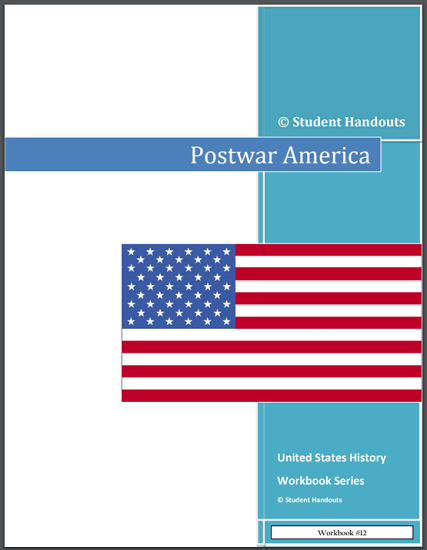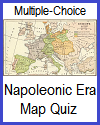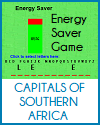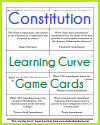| Postwar America—U.S. History Workbook #12 |
|---|
| United States History ↣ American History Workbooks ↣ U.S. History Workbooks for High School |
|
This particular workbook covers the Cold War, Soviet Union, President Harry Truman, Eastern Europe, iron curtain, containment, George Kennan, Truman Doctrine, Marshall Plan, Berlin airlift, NATO, National Security Council, Korean War, establishment of Israel, President Dwight D. Eisenhower, John Foster Dulles, Federal Employee Loyalty Program, House Un-American Activities committee, Alger Hiss, Julius and Ethel Rosenberg, Senator Joseph R. McCarthy, growth of the Sun Belt, suburbanization, Highway Act of 1956, popularity of television, Fair Deal, dynamic conservatism, and much more. This free PDF high school American History workbook is 29 pages in length. The answer key is below. Click here to print. |
 |
    |
|
1 Consensus and Change 1. Henry Luce 2. Cold War 3. Launched a crusade for a larger share of the American dream 2 Cold War Aims 1. 1933 2. To create markets for American agricultural and industrial products, and to ensure tthe ability of Western European nations to export as a means of rebuilding their economies 3. To preclude another attack like that of the Nazis 3 Harry Truman's Leadership 1. Quickly; impulsive on small matters but thoughtful on large matters 4 Origins of the Cold War 1. Vyacheslav Molotov 2. Soviet military forces 3. Winston Churchill 5 Containment 1. Containment 2. George Kennan 3. Middle East and eastern Mediterranean 4. Truman Doctrine 5. George C. Marshall 6. Marshall Plan 7. C - Poland 8. Soviet forces blockaded Berlin, cutting off all road and rail access from the West 9. Allied air forces delivered nearly 2,250,000 tons of goods, including food and coal, to Berlin; lasted 231 days 10. An attack against one member is to be considered as an attack against all, to be met by appropriate force 11. The forum where the President, Cabinet officers, and other executive branch members consider national security and foreign affairs issues 12. Document committed America to assist allied nations anywhere in the world that seemed threatened by Soviet aggression 6 The Cold War in Asia and the Middle East 1. 1949 2. D - Taiwan 3. Korean War 4. Kim Il-Sung 5. Inchon 6. MacArthur challenged Truman's authority by attempting to orchestrate public support for bombing China and assisting an invasion of the mainland by Chiang Kai-shek's forces 7. The region's strategic importance as an oil supplier 8. Israel 7 Eisenhower and the Cold War 1. Dwight D. Eisenhower 2. Answers will vary 3. John Foster Dulles 4. The government would use nuclear weapons if the nation or its vital interests were attacked 5. Against communists in Indochina, against Egypt over the nationalization of the Suez Canal, and against the Israeli invasion of the Egyptian Sinai Peninsula 8 The Cold War at Home 1. Harry Truman 2. Film companies refused to hire anyone with a marginally questionable past 3. Former assistant secretary of state and Roosevelt adviser who was accused of being a communist spy 4. Convicted of participating in a spy network that helped the Soviet Union to develop an atomic bomb 5. He challenged the U.S. Army; people were upset by seeing his savage tactics broadcast on television 9 The Postwar Economy: 1945-1960 1. A measure of all goods and services produced in the United States 2. Public spending for World War II; growth of automobile production; housing boom; rise in defense spending 3. The growth of white-collar jobs 4. Warm and sunny areas of the American South and Southwest 5. suburbs 6. The "hollowing-out" of formerly busy urban cores 7. Highway Act of 1956 8. Howdy Doody Time, The Mickey Mouse Club, I Love Lucy, Father Knows Best, etc. 10 The Fair Deal 1. Fair Deal 2. Helped ease servicemen back into civilian life by providing benefits such as guaranteed loans for home-buying and financial aid for industrial training and university education 3. 21-point program that included protection against unfair employment practices, a higher minimum wage, and greater unemployment compensation 4. B - Harry Truman 5. Banned racial discrimination in federal government hiring practices and ordered an end to segregation 11 Eisenhower's Approach 1. Dwight Eisenhower 2. A.k.a., "modern Republicanism"; "conservative wghen it comes to money, liberal when it comes to human beings" 3. D - sympathetic 4. B - false 12 The Culture of the 1950s 1. A - conformity 2. David Riesman 3. Writers who went out of their way to challenge the patterns of respectability and shock the rest of the culture; stressed spontaneity and spirituality; preferred intuition over reason, Eastern mysticism over Western institutionalized religion 4. Jack Kerouac 5. Allen Ginsberg 6. Elvis Presley 7. Jackson Pollock 13 Origins of the Civil Rights Movement 1. Jackie Robinson 2. C - Discrimination 3. To Secure These Rights 4. Governor Strom Thurmond of South Carolina 5. Jom Crow laws 14 Desegregation 1. National Association for the Advancement of Colored People 2. Plessy v. Ferguson 3. Brown v. Board of Education 4. Orval Faubus 5. Rosa Parks 6. Martin Luther King, Jr. 7. Civil Rights Act of 1957 8. Answers will vary |
| Postwar America Worksheets | Postwar America Learning and Study Games |
| Postwar America Outlines and PowerPoints | Postwar America Maps and Pictures |
| Postwar America Miscellany | Postwar America Books and Films |
| United States History ↣ American History Workbooks ↣ U.S. History Workbooks for High School |








